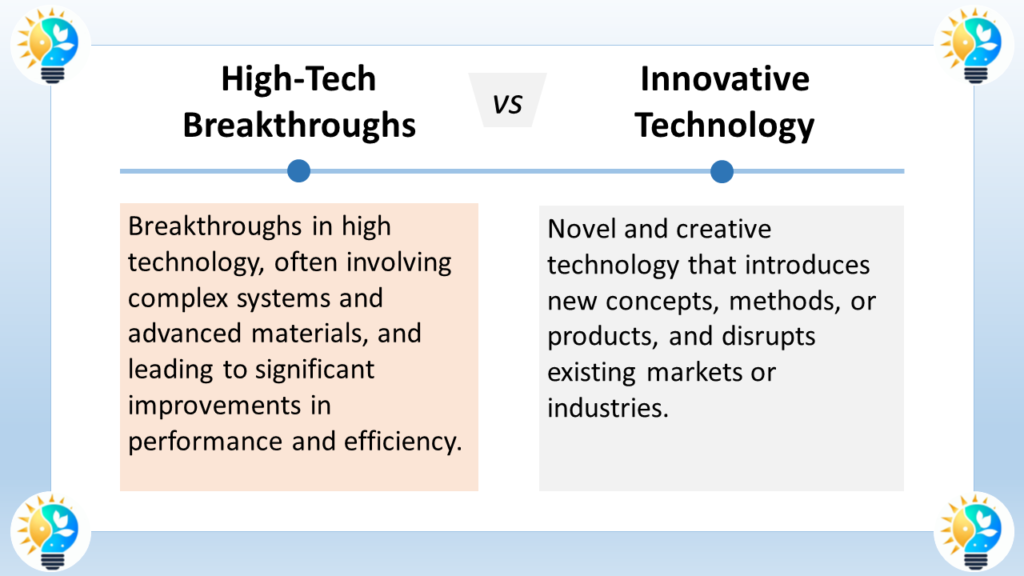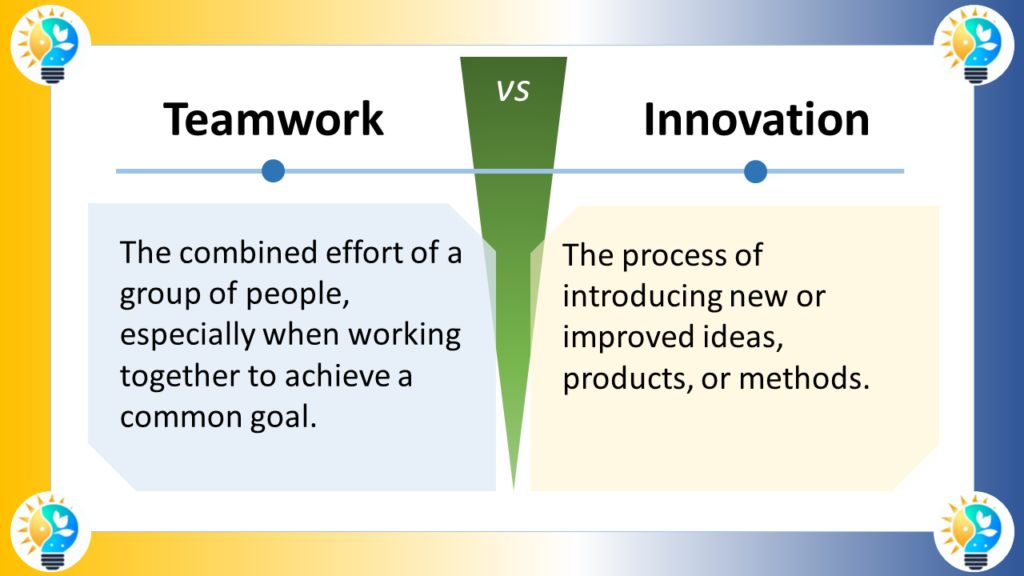High-tech breakthroughs and innovative technology both signify significant advancements, but while high-tech breakthroughs typically focus on technological complexity, innovative technology emphasizes creativity and novel concepts.

In the landscape of technological evolution, Innovative Technology and High-Tech Breakthroughs are terms that are often mentioned in the context of advances that carry us forward. While they are related to progress in technology, they represent different aspects and scales of innovation.
Definitions
Defining Innovative Technology
Innovative Technology refers to new or significantly improved technologies that enhance performance, productivity, or functionality compared to existing solutions. These innovations can be seen as evolutionary steps that address current needs and can be adopted into daily use relatively quickly.
Characteristics of Innovative Technology
- Evolutionary: Represents a step forward rather than a complete overhaul.
- Market adaptability: Designed to fit into existing markets and address immediate needs.
- User-oriented: Often focuses on improving the user experience or meeting user demands.
Defining High-Tech Breakthroughs
High-Tech Breakthroughs, conversely, indicate a significant and often disruptive advance in technology. These breakthroughs can open up new possibilities that were previously unattainable, leading to the creation of new markets and even new industries.
Characteristics of High-Tech Breakthroughs
- Disruptive: Has the potential to change the status quo and create new paradigms.
- Pioneering: Often the first of its kind, opening up entirely new fields of research and application.
- Long-term significance: The full implications and applications may unfold over a longer time frame.
Exploring a Variety of Synonyms for Innovative Technology
- Advanced Technology
- Cutting-Edge Innovations
- Cutting-Edge Breakthroughs
- Disruptive Tech
- Emerging Technologies
- Forward-Looking Tech
- Futuristic Innovations
- Groundbreaking Developments
- High-Tech Breakthroughs
- Innovative Breakthroughs
- Inventive Solutions
- Leading-Edge Advancements
- Modern Technological Breakthroughs
- Progressive Advancements
- Next-Generation Technology
- Novel Tech
- Revolutionary Tech
- State-of-the-Art Solutions
- State-of-the-Art Innovations
- Trailblazing Innovations
- Visionary Tech

Innovation is considered as a driving force in progress.
It includes the introduction of novel ideas, methods, or products that bring positive change and advancement.
For more information about innovations, check our glossary
Innovative vs. High-Tech Breakthroughs: Relationship and Relevance
Innovative technologies are often the result of continuous improvement and adaptation, which can be critical for businesses to maintain a competitive edge. High-tech breakthroughs, while they might stem from innovative processes, represent a more monumental shift, pushing the boundaries of what is considered possible.
Contextual Use of the Terms
Businesses typically invest in innovative technology to optimize operations, enhance products, or improve services. High-tech breakthroughs, while they might attract significant investment, often involve higher risk and require a more visionary approach, with implications that extend beyond the immediate market landscape.
Examples of Utilization
An example of innovative technology could be the development of contactless payment systems. These systems have improved transaction speed and convenience for consumers and are becoming increasingly prevalent in retail environments.
On the other hand, quantum computing represents a high-tech breakthrough. It has the potential to solve complex problems that are intractable for classical computers, impacting fields such as cryptography, drug discovery, and optimization problems.
Comparison Innovative technology vs high-tech breakthroughs
Innovative technology and high-tech breakthroughs are related concepts but have distinct differences. Let’s explore these differences:
- Definition:
- Innovative Technology: Innovative technology refers to the development and application of new or improved technologies that bring about advancements in various fields. It involves the creation of novel solutions, products, or processes that improve efficiency, effectiveness, or user experience.
- High-Tech Breakthroughs: High-tech breakthroughs, on the other hand, specifically refer to significant advancements or discoveries in high-technology industries. These breakthroughs often involve cutting-edge technologies, such as artificial intelligence, robotics, nanotechnology, or biotechnology, and have a profound impact on industries and society as a whole.
- Scope:
- Innovative Technology: Innovative technology can encompass a wide range of industries and sectors, including but not limited to high-technology fields. It can involve advancements in areas such as healthcare, transportation, communication, energy, and more.
- High-Tech Breakthroughs: High-tech breakthroughs are specifically focused on advancements in high-technology industries. These industries typically involve complex and advanced scientific knowledge and require specialized expertise.
- Impact:
- Innovative Technology: Innovative technology can have a significant impact on improving existing processes, products, or services. It may lead to increased efficiency, cost savings, enhanced user experience, or the creation of entirely new markets.
- High-Tech Breakthroughs: High-tech breakthroughs often have a transformative impact on industries and society. They can disrupt traditional business models, create new industries, revolutionize healthcare, change the way we communicate, or address global challenges.
- Research and Development:
- Innovative Technology: Innovative technology can result from ongoing research and development efforts, incremental improvements, or the application of existing technologies in new ways. It may involve collaborations between different industries or interdisciplinary approaches.
- High-Tech Breakthroughs: High-tech breakthroughs often require extensive research and development efforts, involving specialized expertise and significant investments. They may involve breakthrough discoveries, revolutionary inventions, or the development of entirely new technologies.
In summary, innovative technology refers to the development and application of new or improved technologies across various industries, while high-tech breakthroughs specifically focus on significant advancements in high-technology fields. High-tech breakthroughs often have a transformative impact on industries and society, while innovative technology can lead to incremental improvements or the creation of new solutions.
FAQ
Q: Is every high-tech breakthrough initially recognized as such?
A: Not always. The full potential of a high-tech breakthrough may not be immediately evident and can take time to be fully realized and appreciated.
Q: How do high-tech breakthroughs affect the economy?
A: High-tech breakthroughs can lead to the creation of new industries, spur economic growth, and drive job creation in emerging sectors.
Q: Do innovative technologies always precede high-tech breakthroughs?
A: While not a strict rule, many high-tech breakthroughs are built upon a foundation of earlier innovative technologies.
Q: Can a single company be responsible for a high-tech breakthrough?
A: While a single company can spearhead a high-tech breakthrough, the development often involves collaboration across multiple organizations, including academia, research institutes, and industry partners.
Q: Do high-tech breakthroughs guarantee commercial success?
A: Commercial success is not guaranteed and depends on factors such as market readiness, the breakthrough’s practical applications, and the ability to scale up the technology.


